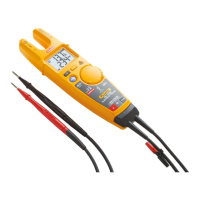, then using
F2
select COUPLING AC.
• Press
B
, then using
F2
select COUPLING AC.
• Press
C
, then using
F2
select COUPLING AC.
• Press
D
, then using
F2
select COUPLING AC.
• Press
CLEAR
to clear the softkey menu, and to see the full screen.
3. Using
TIMEsns
change the time base to select manual time base ranging, and lock
the time base on 50 ms/div.
4. Press
RANGE
select manual vertical ranging, and set the Input A sensitivity
range to 500 mV.
6. Set the 5500A to source the appropriate ac voltage and frequency, according to
Table 4-4.
7. Observe the reading
A and check to see if it is within the range shown under the
appropriate column.
8. Continue through the test points.
9. Next check channel B, C or D in succession:
Press
TRIGGER
and select B, C or D as trigger source with
F1
,
Press B, C or D to assign vertical ‘range’ and ‘move’ to channel B, C or D,
Observe reading B, C or D
10. When you are finished, set the 5500A to 0 (zero) Volt, and to Standby.
Table 4-4. Input A, B, C, D AC Input Coupling Verification Points
5500A output, V rms 5500A Frequency Reading A, B, C, D
900 mV 60 Hz 873 mV to 927 mV
900 mV 5 Hz >630 mV
4.6.5 Input A and B Peak Measurements Test
WARNING
Dangerous voltages will be present on the calibration source
and connecting cables during the following steps. Ensure that
the calibrator is in standby mode before making any connection
between the calibrator and the Test Tool.
Proceed as follows to test the Peak measurement accuracy:

